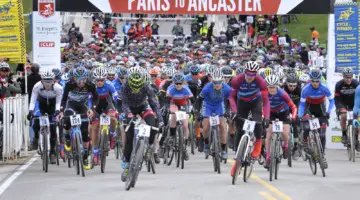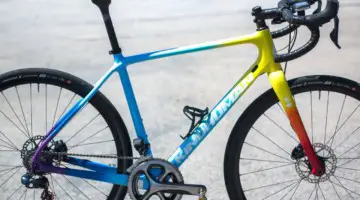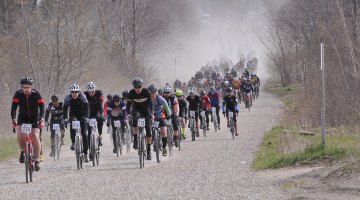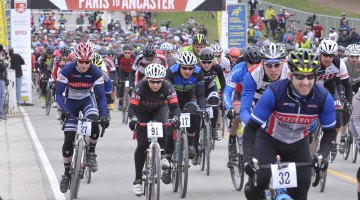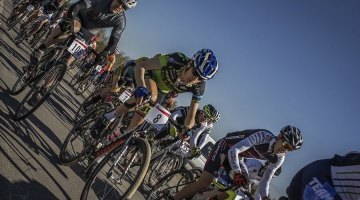The 21st edition of Paris to Ancaster saw an Elite field brimming with talent and a course to ready to test even the most skilled riders. Held on the outskirts of Hamilton, Paris to Ancaster is a point-to-point gravel (and road, and mud) race roaming across the roughest farm lanes, trails, and gravel roads of Ontario. It attracts many of the strongest riders from both the US and Canada. Piggybacking off our success at Barry Roubaix and Lowell 50, WASLabs elected to send three riders up north to test our hand on Canadian soil. Going into the race, we were under the impression that this would be more of a dirt road race, but a quick pre-ride Saturday afternoon convinced us otherwise. Several mud chutes towards the end, coupled with single track and a decisive finishing climb, assured the race would finish in small groups.
We headed to the start a little early to try and preview the first couple of turns and warm up. Start temperatures were hovering in the mid to low 40s. Some racers were removing leg warmers while other, more fragile riders (i.e. your author), were in thermal skin suits, leg warmers and winter gloves. Call-ups complete, the tension in the air was thick. There was a long, slightly up hill stretch of pavement before we made a right on to the first of many dirt sections. Like most cyclocross races, there was the race to get the start line for good starting position, followed by the race to the first corner.
We all made it through the corner cleanly, but there was no settling in as this was one of the few sections to move up before we turned onto a narrow rail trail. People were crushing it in the big ring hitting potholes, bottles were flying, only to slam on the brakes to avoid hitting the bollards placed at the entrance of the rail trail. While narrow, it still offered some opportunities to move up on the outside, or if you were pushy you could make your way up the middle. Once I made it to a more comfortable spot, things started to get nervous at the front again. It was then that I realized that I had not done enough work to get into the right spot. The rail trail made a hard 180 degree turn on to a steep pitch. The leaders were able to ride the section, while those of us farther back were forced to dismount and run in order to avoid several riders who had crashed. Having not run since last fall, it was an… experience.
I tried to stay patient and worked my way back up to the leaders on the next dirt road section. I didn’t have much time to catch my breath as we made a transition from the dirt to single track. The entrance was a six foot deep ditch that had a pallet stretched across it. The pallet was wobbly, mud-covered and not nearly wide enough for the 200+ riders bearing down on it. I elected to run through the ditch, which was equally as hard given the brush on either side. This was the beginning of the end of my race in many ways. The leaders were able to dismount and quick get back on their bikes to ride the upcoming muddy single track. For those of us further back, it was a huge bottleneck. In this section alone we lost two or three minutes. Trying to remount while riders are wrecking around you made it feel just like a ’cross race. Once we exited the single track, I realized just how much work I had left myself. Shawn and Matt and made it through in the second and third groups on the road. I was in 15th. Back to management mode.
Shawn and Matt were in similar situations up the road. The leading group of about 12 riders had made their escape and the chasing groups were less than motivated to continue racing. Feeling frustrated, both with the day, and my situation, I began a series of bridges. Eventually I made it up to 12 riders, who all seemed interested in continuing to race. Slowly we picked up more riders who were falling off the pace at the front, and the group swelled to almost 20. I resolved after the mishap earlier in the race to not be any further back than second wheel when entering any single track or double track. Granted this was a bit easier with 20 riders instead of 200, but it was good practice. Once we were on anything technical, I tried to keep the pace high. I knew that we were getting close to the end, but with two mud chutes left there were plenty of opportunities for the race come back together.
I entered the first chute alone after attacking out of the group. I wasn’t sure how fast I could take the muddy downhill without flatting, but I figured it was better to be caught than dropped. The section took our group from 20-25 down to about 10 riders. We kept the pace high on the dirt road that followed as it was only a few kilometers till the next chute. Again I attacked on the dirt road climb into the chute and was first in. Mike Simonson was running a tire that was a bit wider than mine and came bombing down the ride side of the gully. It was all for nothing, as I believe he dropped his chain at the exit, but his skills and my attacking had made a selection of five going into the final single track.
On the next section I broke my rule about going into the single track first, but I knew that there was a sizeable dirt road climb to the finish. I upped the pace as soon as we were at the base, not knowing if we were racing for 10th or 300th. In the end, it was for 30th. We nearly caught the tail end of the group, which included Shawn and Matt. Their group had also broken up into smaller pieces, and they found themselves racing for a top 10 result.
Now being a P2A veteran, I would tell anybody who asks that this race brings together a mix of every cycling skill set, so come prepared. Knowing the course (which changes slightly every year) is huge advantage. There will be mud, rocks, pavement, sand, ditches, roots, and hundreds of other racers who are looking to wreck you. It is a race that must be ridden from the front; hiding will only get you dropped. As a team we are satisfied with our debut at P2A, but being close, our results left us wanting just a little bit more. We will be back next year. Thanks to our hosts in Canada, the hundreds of volunteers, WASlabs, Raleigh, and Portage Cyclery. Great events like this would not be possible without the proper support. See everyone next April!
























